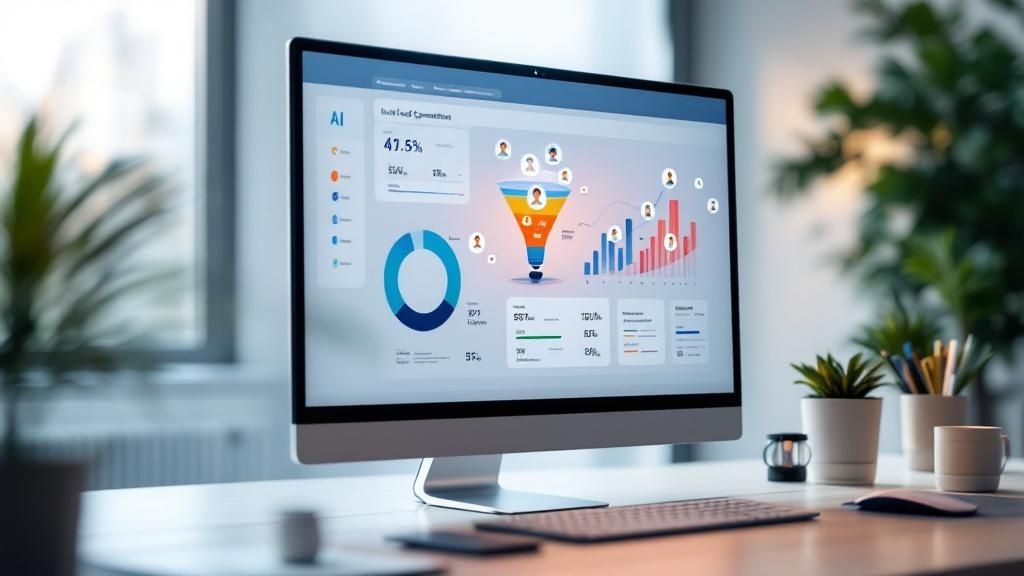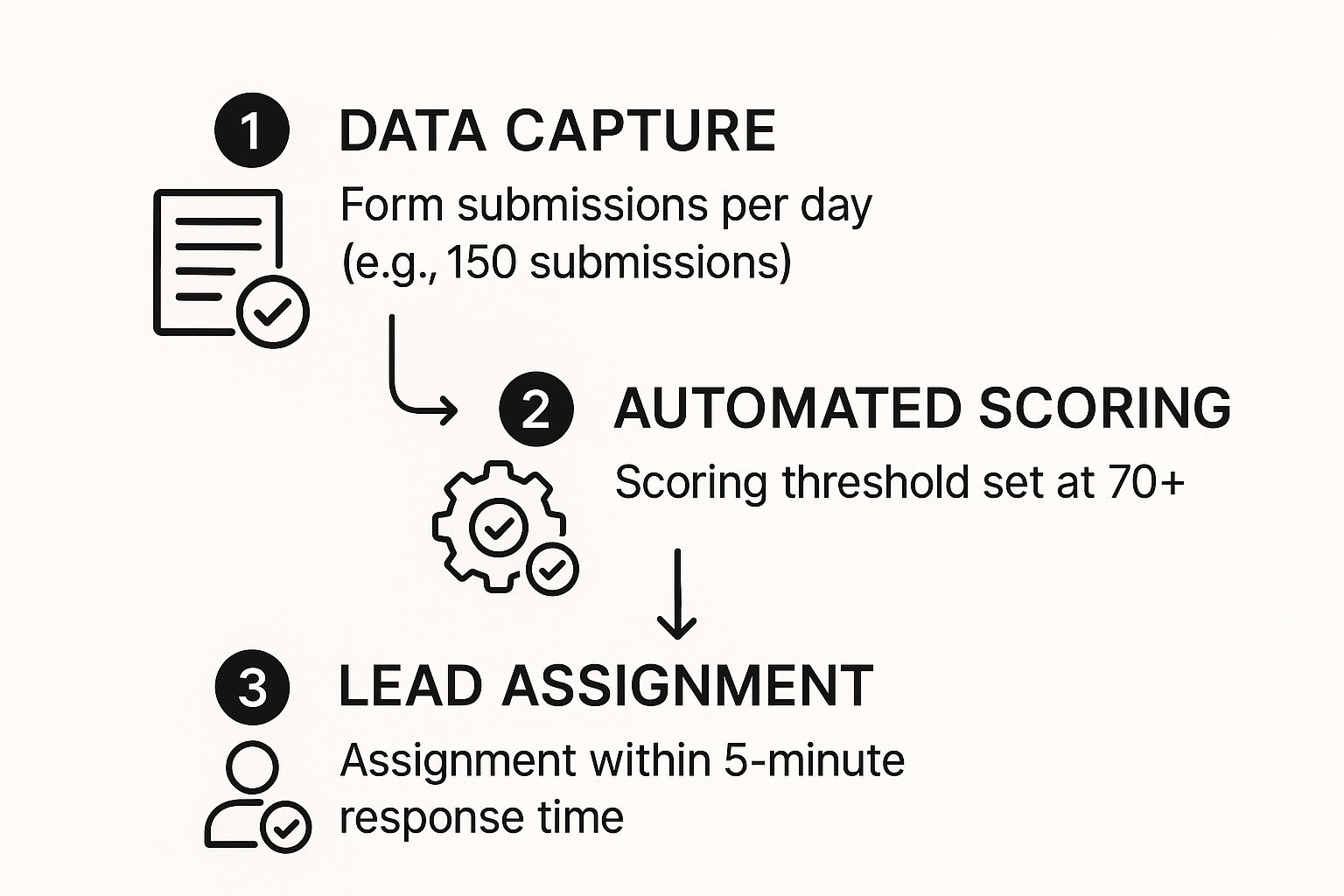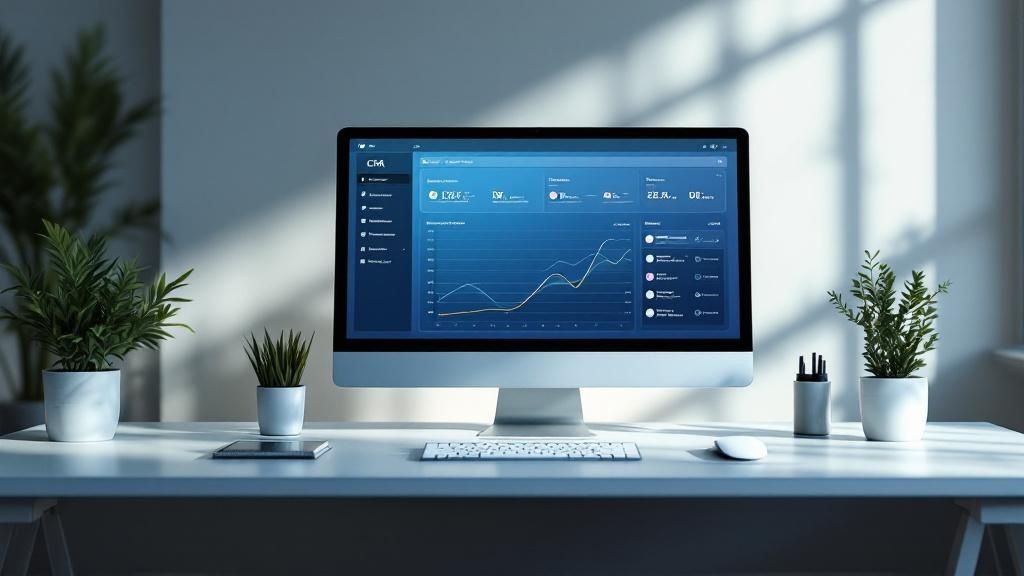Let's be honest: trying to scale your business with manual lead generation is like trying to win a drag race on a bicycle. It just can't keep up. The real struggle for most businesses isn't a lack of effort; it's figuring out how to grow lead acquisition without having to endlessly hire more people or throw more money at the problem.
The answer lies in building a smart, automated lead generation system. This turns a high-effort, low-return task into a powerful business asset that works for you around the clock.
Why Automated Lead Generation Is No Longer Optional

In today's crowded digital world, manual processes simply don't have the horsepower to compete. You're constantly fighting against market noise and saturation, which calls for a much smarter strategy than sheer brute force. This isn't just about plugging in a new tool; it’s about completely re-engineering your approach to finding, qualifying, and talking to potential customers.
This shift toward automation is born out of pure necessity. You need a system that captures opportunities 24/7, even when your team is off the clock.
The Problem with Doing Things by Hand
Sticking to manual lead generation creates huge bottlenecks that choke your growth. Think about it: your sales reps are sinking countless hours into repetitive, soul-crushing tasks. Finding contact info, sending that first email, logging every little activity—it's a time-suck that keeps them from what they should be doing: having valuable conversations with qualified prospects.
The numbers tell a pretty stark story. While lead generation is a top priority for about 50% of marketers, the results are often dismal. A mind-boggling 97% of people reportedly ignore cold calls, and 44% of sales reps admit they're too swamped to follow up on every lead they get. That's a massive gap between effort and results, and it's a gap that automation is built to close.
"The core issue isn't a lack of effort; it's a lack of leverage. Manual outreach is a linear game—one action equals one result. Automation introduces exponential potential, where one setup can produce thousands of targeted interactions."
To get a sense of just how different the two approaches are, here's a quick side-by-side comparison.
Manual Effort vs Automated System At a Glance
| Aspect | Manual Approach | Automated System |
|---|---|---|
| Scale | Linear growth; requires more people for more output. | Exponential growth; increases outreach without a proportional increase in staff. |
| Team Focus | Repetitive tasks (data entry, initial outreach). | High-value activities (relationship building, closing deals). |
| Consistency | Varies by rep; prone to human error and fatigue. | Standardized, on-brand communication for every lead. |
| Operating Hours | Limited to the team's working hours (9-to-5). | Runs 24/7, capturing leads across all time zones. |
| Lead Management | Leads can easily fall through the cracks. | Systematic tracking ensures timely follow-up for every lead. |
| Efficiency | Low; significant time spent on low-impact work. | High; frees up human talent for strategic, revenue-focused work. |
This table makes it clear: clinging to old methods isn't just inefficient, it's a competitive disadvantage.
The Automation Advantage
An automated system fundamentally transforms how you acquire customers. You're essentially building a machine that consistently identifies, engages, and qualifies leads based on rules you set. This systematic process ensures no lead gets left behind and every prospect gets the right message at the right time.
Here's where you really see the power:
- Scalability: You can 10x your outreach without needing to hire 10 more people. The system handles all the heavy lifting.
- Efficiency: By taking repetitive work off their plates, your sales team can focus entirely on revenue-generating activities, like actually closing deals.
- Consistency: Every single lead gets the same high-quality, on-brand experience, building trust from the very first touchpoint.
The smartest companies are already taking the next step by exploring how supercharging B2B lead generation with AI can give them an even greater edge. This move from manual to automated isn't just an upgrade—it's becoming essential for survival and growth.
Crafting Your High-Conversion Lead Capture Points

Think of this as the digital handshake—it's the first real moment of connection between your automated system and a future customer. A truly effective automated lead generation strategy isn't built on a single, lonely "Contact Us" form. It’s a whole network of smart, well-placed capture points.
Our job is to create a seamless, value-packed experience that makes sharing contact info feel like the natural, obvious next step for your visitors. It’s less about asking for an email and more about offering something genuinely useful in return, right where your prospects are in their journey.
Engineering Your Landing Pages for Action
A landing page has one job and one job only: to convince a visitor to take a very specific action. It's not just another page on your website; it’s a purpose-built conversion machine. For it to work, the value you're offering has to be glaringly obvious from the second the page loads. No guesswork allowed.
Let's say you're offering a "Comprehensive Guide to B2B SEO." The landing page can't be subtle. It needs a headline that hits hard, like "Stop Guessing. Start Ranking. Get Your Free B2B SEO Guide." Show a sneak peek of the guide, use bullet points to list the key takeaways, and make every single element—from the images to the button text—scream value.
A landing page is a focused conversation. If your main website is a bustling department store with many options, your landing page is a boutique with one curated item on display. Don't distract from the sale.
This focus is everything. Ditch the navigation links, sidebar offers, and generic company fluff. Anything that doesn't directly support that one call-to-action (CTA) is just giving your visitor an escape hatch. While there are many ways to automate lead generation, none of them matter if your capture point is weak.
Beyond Forms: Smart Pop-Ups and Chatbots
Let's be honest, traditional contact forms are pretty passive. They just sit there, waiting for someone to fill them out. Modern lead generation gets proactive, engaging visitors at just the right moment.
Smart pop-ups, for example, can be triggered by what a user is actually doing. Instead of an annoying, in-your-face pop-up the second someone lands on your site, you can set triggers based on behavior.
- Exit-Intent: This is a game-changer. When a user's cursor moves to exit the page, you can serve up a last-ditch offer—a discount, a helpful resource—to keep them around.
- Time on Page: Someone's been reading a blog post for a full minute? They're clearly interested. Now's the perfect time to suggest a related e-book.
- Scroll Depth: A visitor just read 75% of a detailed article? That's a highly engaged prospect. Hit them with a relevant offer.
This turns a potentially intrusive element into a genuinely helpful one.
AI-powered chatbots take this a step further. They don't just collect information; they engage, qualify, and segment leads in real-time. These bots work 24/7, having conversations, answering questions, and routing hot leads straight to your sales team, all before a human has to lift a finger.
Creating Irresistible Lead Magnets
A lead magnet is your currency. You're trading a piece of valuable content for a prospect's contact information. A weak "subscribe to our newsletter" offer just isn't going to cut it anymore. Your offer has to solve a real, specific problem for your target audience.
The goal is to provide an immediate win.
Powerful Lead Magnet Examples:
- For a software company: Instead of a product brochure, offer a checklist like, "10 Critical Security Flaws Your Current System Might Have." That's compelling.
- For a marketing agency: Forget a generic service list. Create an exclusive video workshop on "How to Build Your First Profitable Ad Campaign in 30 Minutes."
- For a financial consultant: A downloadable calculator for "Projecting Your Retirement Savings" offers instant, personalized value that a blog post can't.
Specificity is your best friend here. The more closely your lead magnet relates to the content someone is already consuming, the higher your conversion rate will soar. This value-first approach builds immediate trust and positions your brand as an expert, making the whole exchange feel less like a transaction and more like the start of a great relationship.
Designing Outreach Sequences That Actually Connect
Getting a new lead is great, but that’s just the starting gun. The real race in automated lead generation is what happens next. The quality of your follow-up conversation is what separates a prospect who leans in from one who hits "unsubscribe."
Building automated outreach that feels human is a bit of an art, but it’s backed by science. It’s all about creating a helpful, persistent dialogue that guides people toward a solution without ever feeling robotic or pushy. This is where you use technology not just to talk, but to listen and react.
Map Your Sequences to Your Lead’s Intent
A one-size-fits-all follow-up sequence is a recipe for disaster. The way you talk to someone who just downloaded a hefty, 50-page whitepaper should be completely different from how you approach someone who signed up for a webinar. The trick is to match the intensity and depth of your outreach to the lead's first move.
Think about it: a whitepaper download screams, "I'm digging deep into a specific problem." This person is probably in the thick of research. A longer, more educational nurture sequence is a perfect fit.
For example, a 5-touch nurture for a whitepaper download could look like this:
- Immediately: Send an email delivering the goods with a brief, helpful note.
- Day 3: Follow up to ask if they had questions and share a relevant case study.
- Day 7: Send a LinkedIn connection request, mentioning the whitepaper topic in your note.
- Day 12: Email a short video that breaks down a key concept from the paper.
- Day 18: Offer a no-pressure chat to discuss their specific challenges.
This sequence gives them breathing room and focuses on adding value at every single touchpoint, building trust along the way.
Now, contrast that with a webinar registrant. Their interest might be more immediate, but maybe less intense. Attending a live event is a strong signal, for sure, but they might not be as far down the research rabbit hole. A shorter, more direct sequence usually works better here.
A 3-touch sequence for a webinar registrant might be:
- Immediately: Email the webinar recording and slides.
- Day 2: Highlight a key takeaway and ask an engaging question to get a conversation started.
- Day 5: Send a direct call-to-action for a demo, tying it back to the webinar's main theme.
This approach is quicker and laser-focused on turning that initial interest into a real sales conversation. The goal isn't just to automate; it's to orchestrate the right conversation with the right person at the right time.
The Power of Conditional Logic
This is where your automated lead generation gets really smart. Conditional logic lets your outreach adapt on the fly based on what a lead actually does. Instead of marching everyone down the same rigid path, you create a dynamic, branching conversation that responds to their actions.
The core idea is simple: If a lead does X, then send Y. But if they do Z, send A instead. This is what makes your automation feel responsive and genuinely relevant.
Let's go back to our lead who downloaded the whitepaper. In that email on Day 3, you shared a link to a case study. Your system can—and should—track whether they click it.
- If they click the case study link: That's a huge buying signal! They are actively looking at solutions. Your system can automatically tag them as "high-engagement" and trigger a more sales-focused email just two days later.
- If they don't click: They might just need a little more warming up. No problem. The system simply continues with the original plan, sending the educational video on Day 12 to keep building value.
This responsive approach makes sure you're always sending the most fitting message. You can speed things up for hot leads while continuing to patiently nurture the cooler ones.
This infographic shows just how automation streamlines those early stages, from capturing data to scoring and assigning leads for a lightning-fast follow-up.

You can see the efficiency gains right there—a high volume of daily submissions can be processed, scored, and handed off in minutes. No more letting qualified leads go cold.
Go Beyond Just the First Name
Real personalization is so much more than dropping a {FirstName} token into a template. That's table stakes. To truly connect, you have to personalize the substance of your message.
Effective personalization tokens can pull in all sorts of data to make your outreach feel like it was written just for them:
- {CompanyIndustry}: "Saw you're in the {CompanyIndustry} space, where we've seen great results with…"
- {JobTitle}: "As a {JobTitle}, you're probably wrestling with challenges like…"
- {LeadSource}: "Since you downloaded our guide on {LeadSource}, I thought you'd find this related article useful."
When you combine these powerful tokens with the conditional logic we talked about, you create a communication flow that feels less like a marketing blast and more like a one-on-one chat. This is the secret to creating outreach sequences that don't just get opened—they get replies. You’re building a helpful, persistent conversation that moves prospects forward because it actually understands and responds to who they are and what they do.
Using Lead Scoring to Empower Your Sales Team

Once your marketing machine starts humming and leads are flowing in, you hit the next big challenge: figuring out where your sales team should actually focus. A flood of leads is great, but it's completely useless if your reps are drowning in a sea of unqualified contacts.
This is where a smart automated lead generation system truly shines. By using lead scoring, you can finally separate the hot, ready-to-buy prospects from the casual window shoppers.
Think of lead scoring as the engine of sales efficiency. It's a system for assigning points to each lead based on who they are and how they interact with you. The goal is simple: create a clear, data-driven pecking order that tells your sales reps exactly who to call first. This ensures their valuable time is spent on conversations with the highest potential to convert.
Demystifying the Scoring Model
Building a scoring model isn't as intimidating as it sounds. I've found it helps to break it down into two core components: demographic information (who the lead is) and behavioral information (what the lead does). Combine the two, and you get a fantastic, holistic view of a lead's fit and intent.
Demographic Scoring is all about how well a lead matches your Ideal Customer Profile (ICP). You're basically giving points for how much they "look" like your best customers.
- Job Title: A "Director of Marketing" might get a solid +15 points, while someone with "Student" in their title gets -10.
- Company Size: If you primarily sell to mid-market companies, a lead from a business with 50-500 employees could get +10 points.
- Industry: A lead from a key industry, like SaaS, might receive +10 points.
Behavioral Scoring, on the other hand, is where things get really interesting. It tracks a lead's engagement with your brand, which are powerful indicators of their interest and buying intent.
- Website Visits: Someone visiting your pricing page is a huge signal. I'd give that at least +20 points.
- Content Downloads: Downloading an in-depth case study (+15 points) shows much more intent than a top-of-funnel checklist (+5 points).
- Email Engagement: Opening an email is a good start (+2 points), but clicking a link inside is way better (+5 points).
- Demo Request: This is the ultimate hand-raise. It's a direct request to talk, easily worth +50 points.
To put it all together, I’ve mocked up a simple table showing how you might structure this.
Example Lead Scoring Model
This table shows how you can assign points to different lead attributes and actions to gauge how sales-ready they are.
| Attribute/Action | Criteria | Points |
|---|---|---|
| Demographic | Job Title is C-Level or VP | +20 |
| Company Size is 100-1,000 employees | +10 | |
| Industry is a primary target (e.g., Tech) | +10 | |
| Behavioral | Visited Pricing Page | +20 |
| Attended a Webinar | +15 | |
| Downloaded a Case Study | +15 | |
| Requested a Demo | +50 |
With a model like this, you can set a clear threshold. For instance, you might decide that any lead who scores 70 points or more is officially a Marketing Qualified Lead (MQL) and ready for a sales conversation. This data-driven approach removes the guesswork.
Automating the Handoff to Sales
The moment a lead hits that magic MQL score, automation should kick in. This is where you set up routing rules to ensure no hot lead ever goes cold. You can create a workflow that triggers instantly when a lead's score blows past your threshold.
The real power of lead scoring isn't just identifying hot leads—it's delivering them to the right person at the right time, with all the necessary context.
This automated handoff is a game-changer. It usually involves:
- Instant Notification: The assigned sales rep gets an immediate email or Slack alert. No more waiting.
- CRM Integration: The lead's profile, score, and complete activity history are automatically synced to your CRM.
- Task Creation: A "Follow-Up" task is created and assigned to the rep in the CRM, often with a specific response time SLA to ensure accountability.
This seamless process eliminates tedious manual work and empowers your team to act on strong buying signals in minutes, not days. It's a critical piece of the puzzle for making any multichannel strategy truly effective, especially when you're exploring things like how LinkedIn automation done right can supercharge your efforts.
As AI's role in sales deepens, remember that authenticity is your most valuable currency. Sloppy automation can feel robotic and instantly erode trust. In a world where buyers are more skeptical than ever, your scoring and outreach systems must pave the way for genuine, helpful interactions. That's how you build the credibility needed to turn a lead into a customer. For more on this, Dux-Soup.com offers great insights on building trust.
How to Measure and Optimize Your Automation Engine
Getting your automation engine up and running is a huge milestone, but it's really just the starting line. The real magic happens when you treat it less like a machine on autopilot and more like a living, breathing part of your business—something that needs regular check-ups and fine-tuning. A system left to its own devices will eventually sputter out. It’s the continuous optimization that transforms a good system into a great one, delivering results that compound over time.
This isn't about drowning in a sea of vanity metrics. It's about a relentless focus on the key performance indicators (KPIs) that actually move the needle for your business. You need a solid, no-nonsense framework for figuring out what’s working, ditching what isn’t, and constantly pushing for better performance.
Identifying the KPIs That Truly Matter
To really get a grip on what's happening under the hood, a solid understanding of marketing analytics is non-negotiable. Instead of getting distracted by every data point you can track, you need to zero in on the metrics that paint a clear picture of your automated lead generation engine's health.
Here are the essential KPIs you should be watching like a hawk:
- Lead-to-MQL Conversion Rate: This is your north star metric. It tells you what percentage of raw leads actually meet your criteria to become a Marketing Qualified Lead. If this number is low, it’s a red flag that there’s a disconnect between your lead magnets and what your sales team actually considers a good prospect.
- MQL-to-SQL Conversion Rate: This one tracks how many of your MQLs are accepted by the sales team as legitimate Sales Qualified Leads. A big drop-off here is a classic sign that your lead scoring rules are off and need a serious tweak.
- Sales Cycle Length: How long does it actually take for a brand-new lead to turn into a paying customer? Your automation should be making this cycle shorter. If it's not, your nurture sequences probably aren't hitting the right notes or addressing your buyers' biggest sticking points.
- Email Engagement Rates: Look past the simple open rates. The real story is in your click-through rates (CTR) and, even more importantly, your reply rates within your nurture campaigns. These numbers tell you directly how much your message is resonating with your audience.
The goal isn't just to generate leads; it's to generate momentum. The right KPIs show you where your funnel has friction and where it flows smoothly, guiding you on where to focus your optimization efforts.
A/B Testing Your Way to Higher Conversions
Never, ever assume you know what works best. A/B testing (or split testing) is your most powerful weapon for optimization. It’s a straightforward concept: create two versions of a single element (an 'A' and a 'B'), show them to different segments of your audience, and let the data tell you which one wins.
The key is to avoid testing everything at once. You'll just muddy the waters. Focus on one high-impact variable at a time to get clean, actionable results.
Key Elements to A/B Test:
- Email Subject Lines: Pit a clear, benefit-driven subject line against one that sparks curiosity. Think "Your B2B SEO Guide is Here" versus "Is Your SEO Strategy Missing This?"
- Landing Page Headlines: Your headline is the first thing people see. Test a direct approach like "Automate Your Sales Outreach" against a headline that agitates a problem, like "Tired of Manual Prospecting?"
- Call-to-Action (CTA) Button Text: You'd be amazed how a small word change can impact clicks. Test something standard like "Get Your Free Trial" against a more urgent "Start My Trial Now."
- Form Length: We've all wondered: does asking for a phone number kill conversions? There's only one way to know for sure. Run a test with a shorter form against a longer one and see how it impacts not just the quantity of leads, but the quality, too.
By constantly testing and rolling out the winners, you'll make small, incremental improvements that stack up to massive gains over time.
Analyzing and Plugging Leaks in Your Funnel
Think of your analytics dashboard as a treasure map. It points directly to where your leads are dropping off. A deep dive into your funnel analysis helps you find these "leaks" so you can patch them up by adjusting your automation.
For instance, you might see a huge number of leads vanish after the second email in your main nurture sequence. That's a serious leak. It's your cue to dissect that email. Is the content irrelevant? Is the CTA confusing? Maybe the timing is just off. This is your signal to rewrite the copy, switch up the offer, or adjust the send time.
Or maybe you notice that leads from a certain industry consistently stall out and never hit MQL status. This could mean your lead scoring for that industry is too aggressive, or the content you're sending simply doesn't speak to their unique challenges. The fix? You could build a completely new, hyper-targeted nurture sequence just for them. Making these kinds of smart, data-driven adjustments is what separates a basic setup from a truly intelligent lead generation system. If you want to zoom out and rethink your broader strategy, checking out these 5 lead generation strategies and tips can spark some fresh ideas.
Common Questions About Automated Lead Generation
Diving into automation can feel like a big leap, especially if you're used to doing everything by hand. It’s totally normal to have questions. You're shifting how you find new customers, and that's a big deal. Let's tackle some of the most common uncertainties we hear from businesses, with clear, straightforward answers to help you move forward.
Marketing Automation vs. Lead Generation Automation
It's easy to get these two mixed up, but they play very different roles.
Think of marketing automation as the entire, massive toolbox. It’s got everything you need to manage the full customer lifecycle—from customer retention campaigns and upselling sequences to internal team notifications. It’s the whole system.
Automated lead generation, on the other hand, is one specific, crucial job you do with that toolbox. Its mission is laser-focused on the top of the funnel: attracting, capturing, and nurturing new prospects until they're warm enough for a sales conversation.
All automated lead generation is a type of marketing automation, but not all marketing automation is for generating leads. One is a focused strategy; the other is the tech that powers it all.
Basically, lead gen automation is the engine that fills your pipeline. Broader marketing automation is the system that manages the entire customer journey, from that very first touchpoint to becoming a loyal fan.
What Is the Real Cost to Get Started?
This is the big one, right? The honest answer is: it varies wildly. Your costs will depend entirely on your company's size, your goals, and how complex your needs are. But you don't need a massive budget to get in the game.
A small business or even a solo founder can get a solid automated system up and running for under $100 per month. This usually means connecting a few specialized, affordable tools:
- A simple email marketing platform.
- A tool for building basic landing pages and forms.
- A free or low-cost CRM to keep your contacts organized.
At the other end of the scale, a large enterprise might invest thousands of dollars per month in a powerhouse all-in-one platform like Marketo or an advanced tier of HubSpot. These platforms offer deep analytics, tons of integrations, and sophisticated features for managing complex global campaigns.
The smartest way forward? Start with a system that fits your budget and needs right now. Prove it works, show a clear return on investment (ROI), and then scale up your tools and spending as your business grows.
Can Automation Feel Too Robotic?
This is a huge—and totally valid—concern. The truth is, automation only feels robotic when it's done poorly. A good system uses technology not to fake a human connection, but to deliver personalization at scale. The goal is to make every interaction feel more relevant, not less.
Great automation hinges on segmentation and behavioral triggers. By tracking what a lead actually does—the pages they visit, the content they download, the emails they open—you can send messages that are incredibly specific to their interests.
For example, instead of a generic "Just checking in…" email, you can send one that says, "I saw you just read our case study on the manufacturing industry. We have a new guide on reducing production downtime that you might find interesting." That doesn't feel robotic; it feels genuinely helpful.
The secret is to design every automated step with the customer's experience front and center. Use the tech to deliver the right message at the perfect moment, not just to blast out generic marketing.
How Long Until I See Real Results?
While you can start capturing leads the same day you launch your forms, seeing a real impact on revenue is more of a marathon than a sprint. You have to set realistic expectations.
Generally, you can expect to see a consistent flow of Marketing Qualified Leads (MQLs) and have enough performance data to make smart optimizations within 60 to 90 days.
That timeframe gives your system enough runway to work. It allows leads to move through your nurture sequences and gives you the crucial insights needed to see what’s working and what isn’t. Think of it as building a long-term strategic asset. It's an engine for sustainable growth, not an overnight fix.
Ready to stop chasing leads and start building a system that brings them to you? Salesloop.io provides the tools you need to design, launch, and manage powerful multichannel outreach campaigns. Automate your outreach and accelerate your pipeline growth today.





